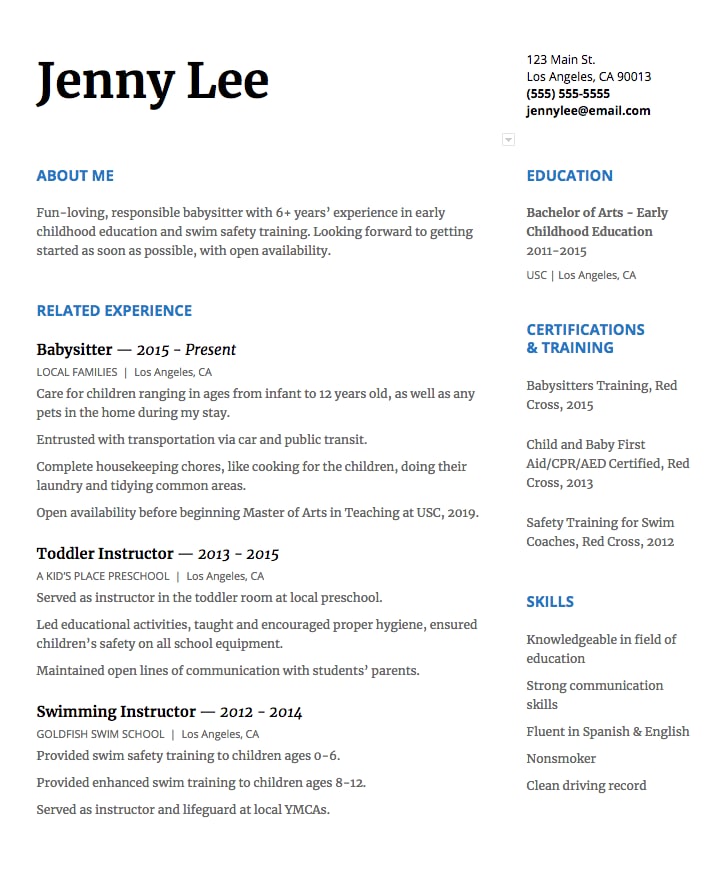The goal of your babysitter resume is, of course, to make it easier for parents to hire you. No matter how many babysitting gigs you’ve had in the past, your resume is often the first thing that prospective employers see when deciding whether to hire you for their babysitting job. This is your opportunity to highlight the great work experience you’ve had, as well as any relevant skills you’ve developed that would tell a prospective family why you’re the right candidate for their needs.
Here’s what to include on a babysitter resume, what to leave off and how to format it, along with a sample resume template and a list of common resume mistakes to avoid.
What to include on a babysitter resume
One of the best ways to determine what information you should showcase on your babysitting resume is by looking at the competition. It helps to know what you’re up against, but more importantly, if you have similar skills or experiences, you’ll want to make sure to highlight them. There are a few ways that you can do this:
- Talk to babysitter friends to ask what they put on their resumes.
- Do internet searches to see sample babysitter resumes.
- If you’re applying via a job website, like Care.com, review other babysitter profiles in your area to see what information and skills they’re choosing to showcase.
As a rule, you should always include your professional experience, education and any certifications or licenses — the items that best show off your babysitting abilities — all on one page so that prospective employers can quickly review and evaluate your credentials to determine what makes you the best fit for their needs.
Here are the five main sections, organized as they should appear from top to bottom on your resume:
1. Contact information
At the top of your babysitter resume, clearly display your full name and contact information, as well as a professional email address (think first and last name; this isn’t the place for your email with the fun, cutesy handle), mailing address and the best contact number for you, such as your personal cell phone. If you have a website or online profile that showcases your babysitting experience and includes helpful information like testimonials, be sure to include the web address in this section, as well, although it is not necessary. Presenting the best contact information at the top of your babysitter resume allows interested clients to easily contact you to schedule an interview.
2. About yourself
The top of your babysitting resume is prime real estate. Underneath your contact information, include a two-to-three-sentence summary of your top selling points, using strong adjectives to describe your work ethic, how many years of experience you have and your preferred availability. Getting these three bits of information right is important to winning over prospective employers at first glance.
3. Work experience
You’re applying for a babysitter job, so this is the place to show off all your applicable child care work experience. Only include experience that is pertinent to the job you’re applying for. This includes any prior babysitting experience, of course, but it may also include other related experience, too — perhaps you’ve worked at a summer camp with young children, tutored the neighbor’s child, babysat for family friends on the weekends or even helped raise your siblings.
Whatever your babysitting know-how includes, be sure to list it out in a clear and concise manner. Include an official job title, the dates you held each position, as well as the location of the babysitting job and a bulleted, short but detailed outline of your job responsibilities (about two or three).
4. Skills and certifications
Any child care training classes, skills and services you provide and certifications you possess should be highlighted in your babysitting resume. This includes certifications such as CPR, water safety, first-aid training or other official designations that help set you apart from other applicants. Other qualifications to include on your resume are relevant tutoring skills, cooking abilities, valid driver license, potty training or other relevant experiences a family may be looking for. These skills, especially those that deal with kids safety and health, are valuable assets for a sitter to have. In a survey of Care.com members, we discovered that two out of three parents said they’d raise their hourly rates by as much as $2 for a babysitter who has extra experience and training.
If you’re lacking in basic child care training and certifications, consider taking a babysitting class or two to bulk up your credentials.
5. Education
Listing your education on your resume helps the family know more about you and your goals. Include the name of the school, such as a college or university, the degree you earned and graduation year. If you’re still in school, list your major, grade point average and your expected year of graduation. Make note of any relevant courses, such as those in early childhood education, that could further bolster your value to families.
Here’s a sample resume example to help guide you in building your own:

(Click here to download this babysitter resume template as a pdf.)
What not to include on a babysitter resume
It may sound counterintuitive, but do not list references directly on your resume.
You should be prepared to provide references, but as a general rule, it’s best to leave them off and simply note “References available upon request” at the bottom of your resume. An exception to this rule would be if the hiring family specifically requests references up front.
How to make your babysitting resume stand out
These items aren’t typically required, but including them can make your resume stand out among the others.
- Cover letter. A cover letter is a great place to express your interest in the job and to personalize your skills in the context of the specific job for which you’re applying. The letter should be concise (roughly three paragraphs) and include a roundup of your qualifications and skills. It’s a good supplemental reminder of who you are and what babysitting services you can provide.
- Professional photo. You may also want to include a professional headshot photo on your babysitter resume or cover letter. This helps families have a visual reminder of who’s who if they are interviewing many candidates.
What common babysitter resume mistakes to avoid
Your resume is likely going to be your first introduction to a prospective employer and will determine your chances of landing that coveted initial interview. It’s also probable that your resume will be used as a deciding factor between final candidates after interviews, so give your sitter resume the same professional treatment as you would any other job resume.
When it comes to building the very best resume, here are some common mistakes to avoid:
- Picking a distracting resume format. Your resume format should be easy to read. Start by choosing a clean and simple sans serif font, like Calibri or Arial, and opt for black text in size 10 or 12. If you’re emailing your resume, consider that the person looking to hire might be viewing the document on their phone, so the easier on the eyes, the better.
- Including every job you’ve ever had. Not all work experience needs to be listed on a babysitter resume. If you’ve held a variety of jobs, list only those relevant to babysitting or child health and safety. Re-read the babysitting job post to see what a family is looking for and match whatever work experience you have based on the ad. Most resumes include three previous jobs (starting with the most recent), but it’s not uncommon to see two or even five if the work experience is relevant.
- Not touting your accomplishments. As you begin to craft your babysitter resume, it can be easy to focus solely on the job responsibilities. But don’t forget to highlight your on-the-job accomplishments and successes as well. For example, if you have extensive experience potty training toddlers, don’t just write, “Experienced in potty training toddlers.” Instead write something that couples both your experience and success, like: “Effectively implemented a variety of potty-training methods, catered to the personality of each child, to successfully teach 15 children, ages 2 and 3, proper bathroom skills.” See the difference? Now, you’ve not only listed your job responsibilities, but you’ve colored it in with your achievements.
- Not proofreading your resume. There’s nothing worse than a glaring grammatical or spelling error on a resume. Once you have a draft of your resume, read it several times over to catch any errors. Make sure all contact information is correct. Consider asking a trusted friend or family member to proofread your resume and provide feedback. It never hurts to let a second (or even third) pair of eyes review the document.
How to handle your babysitter resume going forward
Once you’ve finalized your babysitter resume, be sure to keep it updated as you acquire more work experience or relevant training. It’s a good idea to revisit your resume several times a year and before applying to any new babysitting jobs.
![How to write a babysitter resume that will get you the job [with resume template]](https://www.care.com/c/wp-content/uploads/sites/2/2021/04/alexandrar47-201817172217470532-1620x1080.jpg)





